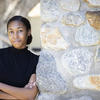Microbe Master
In ancient Egypt, doctors discovered that rubbing moldy bread on an open wound could help ward off infection, kicking off a millennia-long contest to tame bacteria. Now the side of science has a new recruit: Sierra Williams, CST ’16.
In ancient Egypt, doctors discovered that rubbing moldy bread on an open wound could help ward off infection, kicking off a millennia-long contest to tame bacteria. Now the side of science has a new recruit: Sierra Williams, CST ’16.

Photo by Photo credit: Denise Crew
Before I transferred, I hadn’t even visited Temple’s campus. But if it wasn’t for that decision, I wouldn’t be where I am.”

Like any good competitor, Williams starts from a place of respect for her adversary. “I just think bacteria are cool,” Williams said. “We still don’t understand a lot about them.”
Bacteria use chemical signals to communicate, she explained. Research indicates they can impact your physical well-being, for better or for worse. And they’re always adapting, staying one step ahead of the scientists who develop antibiotics to destroy the harmful bugs.
That’s where Williams comes in.
As an undergraduate researcher at Temple, Williams created synthetic chemicals to test their effectiveness in knocking out bacteria. Her proficiency in the lab helped her land internships with Johns Hopkins University and the U.S. Naval Research Laboratory, where she studied special substances that can help treat severe trauma wounds.
After earning her PhD at the University of California, Irvine, Williams is now an assistant professor of chemistry at The Claremont Colleges in southern California. She’ll soon have her own lab staffed with undergraduate researchers, studying how synthetic proteins might be used to build a better antibiotic.
Williams’ path wasn’t always so clear. She started college at a small school in upstate New York, studying environmental science. When she realized it wasn’t what she wanted to be doing, a professor gave her a piece of advice: Find a university doing research that interests you.
That place was Temple. She found several faculty labs extremely intriguing. Plus, the university was closer to her hometown of Capitol Heights, Maryland, and she already knew a few people enrolled. The decision to transfer worked out perfectly for the aspiring scientist. She quickly gained access to important resources, including laboratory training and funding for on-campus research.
“That was crucial because it relieved the burden of me having to work, gain research experience and keep up with my classes, at the same time,” Williams said.
College: College of Science and Technology
Degree: BS, chemistry, 2016
Industry: Science
Hometown: Capitol Heights, Maryland
According to Williams, Temple provided something else essential: a sense of belonging. One of her first professors was Serge Jasmin, an assistant professor of organic chemistry.
“He helped to ease my transition. Having a Black professor that’s teaching chemistry, it was helpful just seeing that representation in the field,” Williams said.
Williams also received support from the Maximizing Access to Research Careers (MARC) Program—a federally funded program to diversify the biomedical field. Through MARC, Williams accessed training on how to interpret scientific papers and present her own research, and received funding to attend conferences and other experiential learning opportunities.
But more than anything, MARC connected Williams to a diverse community of other recipients.
“Having those communities is really important, because it can be hard to find people who are going through similar experiences as you in the classroom and in the research space,” Williams said. “You can support each other on how to thrive in those spaces.
“Don’t be afraid to create those spaces for yourself,” Williams added.